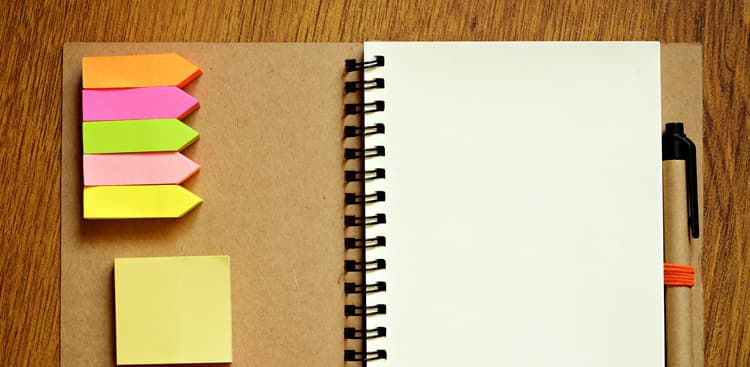LinkedIn released a survey last year revealing that our professional to-do lists are in dire need of a makeover. Turns out, we’re not so good at “doing” the things we tell ourselves we need to do. In fact, almost 90% of professionals admitted they’re unable to accomplish all the tasks on their to-do list by the end of an average workday.
So if you're sick of tackling the same stale to-dos every day, it’s time to change that. Here are five tricks to increase your productivity and help yourself actually make it through your list.
1. Keep a Single To-Do List For Work
Let's be honest: If you wanted to get a complete view of everything you had to do for work right now, chances are you can’t find it all on a single list. Instead, you have a few post-its here, a saved draft in your email there, stickies or text files on your computer, and maybe an app or two on your phone.
And while it's generally good practice to separate work and play, having a single place for your work-related tasks is a must. So pick your method of choice, and start consolidating. It can be anywhere: a handwritten list inside your trusty planner, a document you keep on your desktop, or an app on your phone.
Make sure, however, that you can add to your list from anywhere—which means that if you use a desktop app, you’ll want to set up a system to capture to-dos incurred away from your computer, such as assignments you get while in a meeting. I personally like to write these down on sticky notes, and then delete or toss them once I’ve transferred them to the master list.
2. Follow the 1-3-5 Rule
Now that you have a comprehensive list of everything you have to do for work ever, you should define a daily to-do list. On any given day, assume that you can only accomplish one big thing, three medium things, and five small things. (Note: if you spend much of your day in meetings, you might need to revise this down a bit.) Before leaving work, take a few minutes to define your 1-3-5 for the next day, so you're ready to hit the ground running in the morning. If your position is one where each day brings lots of unexpected tasks, try leaving one medium and two small tasks blank, in preparation for the last-minute requests from your boss.
Yes, I know it can be tough to narrow your list of to-dos down to 1-3-5—but it's important to prioritize. Like it or not, you only have so many hours in the day and you’re only going to get a finite number of things done. Forcing yourself to choose a 1-3-5 list means the things you get done will be the things you chose to do—rather than what just happened to get done.
Planning ahead like this also means you'll be able to have more informed conversations with your manager when he or she drops something new on you that needs to be done right away—as well as the tools to re-prioritize your other work. For example, when a surprise presentation falls on your lap, try: "Sure, I can get that to you by 3 PM, but the Q1 reports won't be ready until tomorrow then, since I'd scheduled to work on that today."
3. Complete One Significant Task Before Lunch (Your Least Favorite One, if Possible)
I'll admit that this one is tough for me, but it works. Take one of your big or medium tasks and tackle it first thing in the morning, before email even if you can. There's no better feeling than crossing off a tough task before lunch. Author Brian Tracy calls this "eating your frog," adapted from the famous Mark Twain quote: “Eat a live frog first thing in the morning and nothing worse will happen to you the rest of the day."
My co-founder, Kathryn, often defines her "frogs" in the evening to prepare for the next day; with that, she's prepared to tackle them in the morning, and it keeps her from pushing off less pleasant tasks for many days.
4. Use Your Calendar as a To-Do list
If you find that you always overestimate how much you can get done in a day, an effective approach is to put your to-dos on your calendar, just like a meeting. Rather than outlining your daily to-dos onto a list, schedule them, leaving enough time each. Sending in your W2 confirmation information to HR might take 15 minutes, while preparing the Q1 strategy for your team may require a few hours. The important thing is to be realistic.
When you try this approach, also make sure you block time in your calendar for catching up on email, brainstorming, or other important-but-not-deliverable-oriented tasks. For example, try blocking an hour in the morning and an hour in the afternoon to work through your inbox—and then don’t spend time in between trying to handle emails the minute they come in, when you’d really planned to be working on something else.
5. Reduce Meetings to Increase Productive Time
Finally, if you find you really can't get done what you think you should be able to in a day, despite all the advice above—consider whether you might be suffering from meeting-itis.
As economist John Kenneth Galbraith once said, "meetings are indispensable when you don't want to do anything." In fact, multiple surveys done on the subject reached similar conclusions that somewhere between a quarter and half of the time spent in meetings is a waste, not to mention, you can’t really get your other to-dos done while you’re sitting down talking to someone else.
The solution: Limit your meetings. Before scheduling a meeting, think about if this could be resolved with an email or phone call first, or by popping into someone's office for a few minutes. If a meeting is required, list the key agenda items to determine the necessary participants and the shortest amount of time you can schedule. And yes, it's totally OK to schedule a 20-minute meeting, no need to round to 30! If you must have meetings, try to group them together to leave large uninterrupted periods of time during your day for the real work to get done.
Yes, reorganizing and planning ahead are both investments upfront—but just think how happy you’ll be when you actually get a full day’s to-do list crossed off. So get yourself organized, get all your to-dos in one place, minimize your distractions, and start conquering that (one-day-sized) list!

